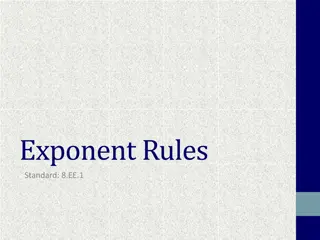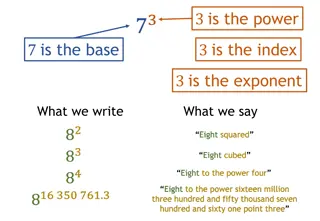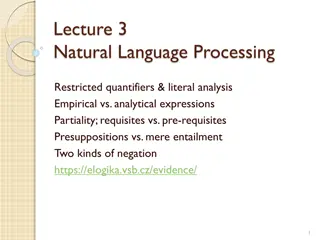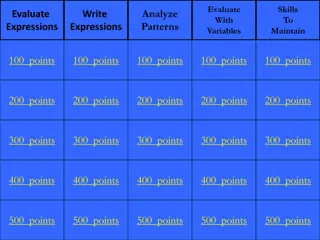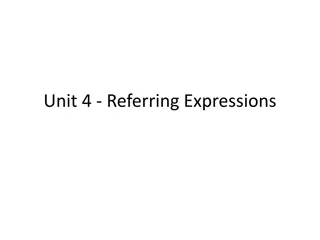Understanding Constant Expressions in C++: Essential Concepts and Best Practices
Explore the crucial concepts of const and by reference in C++, along with their importance and best practices. Dive into the compilation process of C and C++ programs, understand how programs become executables, and discover the significance of compile-time expression evaluation as a powerful conceptual abstraction. Delve into the compilation stages, from source code to machine code, and consider the humble procedure calls exemplified by the Fibonacci sequence calculation in C.
Download Presentation

Please find below an Image/Link to download the presentation.
The content on the website is provided AS IS for your information and personal use only. It may not be sold, licensed, or shared on other websites without obtaining consent from the author. Download presentation by click this link. If you encounter any issues during the download, it is possible that the publisher has removed the file from their server.
E N D
Presentation Transcript
Professor Ken Birman CS4414 Lecture 9 CONSTANT EXPRESSIONS IN C++ CORNELL CS4414 - FALL 2020. 1
IDEA MAP FOR TODAY In Lecture 8 we learned that C++ can automatically compile to vector-parallel instructions. Even without those long lists of advice, this same issue arises when C++ compiles normal code for normal machine instructions! Some styles promote faster code Today we will look at another example, unrelated to parallelism: the C++ concepts of const and by reference . Const is notationally hard to get used to but valuable. By reference is risky to use carelessly, but important to understand! But we also saw longs lists of suggested coding styles intended to make it feasible for C++ to do this! CORNELL CS4414 - FALL 2020. 2
CONNECTION TO CONCEPTUAL ABSTRACTION Lectures 7 and 8 looked at cases in which the C++ compiler can carry out some sort of conceptual transformation or optimization if we understand the design pattern. We saw this with control flow, and with SIMD parallelization. Today we continue this theme by looking at compile-time expression evaluation: another powerful conceptual abstraction! CORNELL CS4414 - FALL 2020. 3
HOW DO PROGRAMS IN C OR C++ BECOME EXECUTABLES? Languages like Python and Java are highly portable. They compile to byte code Java does just in time compilation to machine code. This is not the case for C and C++. Each distinct computer may have a different CPU and its own memory layout rules. Thus, find or cat or tr or sort or uniq needs to be turned into machine-language specific for the particular machine CORNELL CS4414 - FALL 2020. 4
COMPILATION name.c/.cpp, name.h/.hpp: source code name.s: assembler language name.o: object code: machine code plus symbol table name.dll: dynamically linked library a.out: The default name for a compiled executable core: If enabled, a file created in the current directory (or in /var/core) if your program crashes. Use gdb to find out where and why it happened. Compiler option g is useful in this context. CORNELL CS4414 - FALL 2020. 5
CONSIDER THE HUMBLE PROCEDURE CALL In fact, let s look at an example: In fact, let s look at an example: int fibonacci(int n) { if(n <= 1) return n; return fibonacci(n-1)+fibonacci(n-2); } fibonacci(n) computes the n th fibonacci integer fibonacci integer fibonacci(n) computes the n th 1 2 3 5 8 13 21 . 1 2 3 5 8 13 21 = 8 + 13 CORNELL CS4414 - FALL 2020. 6
WHERE IS FIBONACCI PROCESSED? As we will see, in C++ there are several possible answers. The most obvious case is when actual code will be created. Here the compiler itself generates that code. Later we will see other cases where no code is generated! CORNELL CS4414 - FALL 2020. 7
FIBONACCI IS THE MOST FAMOUS EXAMPLE OF RECURSION When first introduced to recursion, many students are confused because 1. The method is invoking itself, 2. The variable n is being used multiple times in different ways, 3. We even call fibonacci twice in the same block! Over time, you learn to think in terms of scope and to view each instance as a separate scope of execution. CORNELL CS4414 - FALL 2020. 8
BUT N DOES NEED A MEMORY LOCATION? Where does the memory for n reside? on the stack. Each time fibonacci is called, C++: Pushes any registers to the stack, including the return PC Pushes arguments (in our case, the current value of n) Jumps to fibonacci, which allocates space on the stack for local variables (in our case there aren t any), and executes When finished, fibonacci pops the PC and returns to the caller The caller pops the things it pushed CORNELL CS4414 - FALL 2020. 9
FIBONACCI(5) int fibonacci(n) { if(n <= 1) return n; return fibonacci(n-1)+fibonacci(n-2); } 15 calls to fibonacci occur, in total CORNELL CS4414 - FALL 2020. 10
FIBONACCI(5) int fibonacci(3) { if(n <= 1) return n; return fibonacci(2)+fibonacci(1); } 15 calls to fibonacci occur, in total CORNELL CS4414 - FALL 2020. 11
WHERE IS TIME BEING SPENT? How many instructions really relate to computing fibonacci? 2 We have an if statement: a comparison (call it compare a and b ) then branch if a >= b . 1 Two recursive calls, one addition, then return. 2 * ? + 1 + 1 CORNELL CS4414 - FALL 2020. 12
THE COST OF THE RECURSIVE CALLS They each Push registers. Probably 1 is in use. 1 1 Push arguments. In our case, n. 2 Push the return PC, jump to fibonacci 2 After the call, we need to pop the arguments and also pop the saved registers. CORNELL CS4414 - FALL 2020. 13
NOW WE CAN FILL IN THE ? WITH 6 How many instructions really relate to computing fibonacci? 2 We have an if statement: a comparison (call it compare a and b ) then branch if a >= b . 1 Two recursive calls, one addition, then return. 2 * ? + 1 + 1 2 * 6 + 1 + 1 CORNELL CS4414 - FALL 2020. 14
HOW MANY INSTRUCTIONS TO PUSH AND POP ARGUMENTS? About 17 instructions per call to fibonacci. Of these, 1 is the actual addition operation, and the others are housekeeping For example: fibonacci(5)=0 1 1 2 3 5 Our code needs to do the required 5 additions. However, to compute it we will do 15 recursive calls at a cost of about 17 instructions each: 255 instructions 51x slower than ideal! CORNELL CS4414 - FALL 2020. 15
SOME QUESTIONS WE CAN ASK When C++ creates space for us to hold n on the stack, why is it doing this? We should have a copy of n if we will make changes, but then would want them discarded, or perhaps if the caller might be running a concurrent thread that could make changes to n under our feet (if the caller is spawning concurrent work). But Fibonacci does not change n! CORNELL CS4414 - FALL 2020. 16
C++ CONST ANNOTATION In C++ we have a way to express that something will not be changed. The compiler can then use that knowledge to produce better code, in situations where an opportunity arises. CORNELL CS4414 - FALL 2020. 17
C++ CONST ANNOTATION The easiest case: const int MAXD = 1000; // Limit on number of Bignum digits char digits[MAXD]; // digits is an array of 1000 8-bit ints Here, we are declaring a compile time constant . C++ knows that MAXD is constant and can use this in various ways. CORNELL CS4414 - FALL 2020. 18
AN EXAMPLE for example, consider digits[MAXD-k-1] = c; movq %rbx,_digits(999-%rax) This sets the item k from the end to 8. C++ can compute MAXN-1 as a constant, and index directly to this item as an offset relative to myvec. By having c and k in registers, only a single instruction is needed! CORNELL CS4414 - FALL 2020. 19
WHY IS THIS SO GREAT? If C++ had not been able to anticipate that these are constants, it would have needed to compute the offset into digits. That would require more instructions. Here, we are leveraging knowledge of (1) which items are constants, and also (2) that C++ puts frequently accessed variables in registers. CORNELL CS4414 - FALL 2020. 20
MORE EXAMPLES USING CONST We can mark an argument to a method with const . This means this argument will not be modified . C++ won t allow that argument to be used in any situation where it might be modified. C++ will also leverage this knowledge to generate better code. CORNELL CS4414 - FALL 2020. 21
MORE EXAMPLES USING CONST We can mark an argument to a method with const . // constant_values1.cpp int main(const int argc, const char**argv) { const int i = 5; i = 10; // C3892 i++; // C2105 } This means this argument will not be modified . C++ won t allow that argument to be used in any situation where it might be modified. C++ will also leverage this knowledge to generate better code. CORNELL CS4414 - FALL 2020. 22
MORE EXAMPLES USING CONST We can mark an argument to a method with const . // constant_values3.cpp int main(const int argc, const char**argv) ) { char *mybuf = 0, *yourbuf; char *const aptr = mybuf; // Initializes aptr *aptr = 'a'; // OK aptr = yourbuf; // C3892 } This means this argument will not be modified . C++ won t allow that argument to be used in any situation where it might be modified. C++ will also leverage this knowledge to generate better code. CORNELL CS4414 - FALL 2020. 23
MORE EXAMPLES USING CONST class Date { public: Date( int, int, int ); Date(const& Date); // A copy constructor int getMonth() const; // A read-only function void setMonth( int ); // Updates month; can't be const private: int month, day, year; }; // constant_member_function.cpp We can mark an argument to a method with const . This means this argument will not be modified . C++ won t allow that argument to be used in any situation where it might be modified. C++ will also leverage this knowledge to generate better code. CORNELL CS4414 - FALL 2020. 24
ASIDE The const suffix for a read-only method like getMonth can only appear inside a method declared as a member of a class. It means read only property of the object the class defines. If you used this same notation on a global method, it will be rejected with an error message. CORNELL CS4414 - FALL 2020. 25
ANOTHER ASIDE A constant lives in the compiler not in program memory, unless the compiler needs to save a copy for some reason. As a result, you cannot access a constant by reference: when you take the address of an object, or pass it using the & notation for a parameter to a method (like sum(int& x, int& y)), you are treating the constant as if it has a location in memory. CORNELL CS4414 - FALL 2020. 26
BUT CONST CAN ALSO MEAN I DONT CHANGE THIS ARGUMENT In this sum function, we are saying sum will treat a and b as constants (it won t change them). It accesses them by reference, so you cannot pass a constant to it CORNELL CS4414 - FALL 2020. 27
BUT CONST CAN ALSO MEAN I DONT CHANGE THIS ARGUMENT In this sum function, we are saying sum will treat a and b as constants (it won t change them). It accesses them by reference, so you cannot pass a constant to it The const at the end says that this method will not change member variables in the class that defined it. CORNELL CS4414 - FALL 2020. 28
CONSTEXPR This keyword says that this expression should be entirely constant . The expression can even include function calls. C++ will complain if for some reason it can t compute the result at compile time: a constant expression turns into a result during the compilation stage. If successful, it treats the result as a const. CORNELL CS4414 - FALL 2020. 29
CONSTEXPR This annotation says that this expression should be entirely constant . The expression can even include function calls. constexpr float x = 42.0; constexpr float y{108}; constexpr float z = exp(5, 3); constexpr int i; // Error! Not initialized int j = 0; constexpr int k = j + 1; //Error! j not a constant expression C++ will complain if for some reason it can t compute the result at compile time: a constant expression turns into a result during the compilation stage. If successful, it treats the result as a const. CORNELL CS4414 - FALL 2020. 30
FUNCTIONS USED IN CONSTANT EXPRESSIONS To use a function in as an initializer for a const, or in a constexpr, the function itself must be marked as a constexpr. The compiler will complain if any aspect of the function cannot be fully computed at compile time. CORNELL CS4414 - FALL 2020. 31
WE CAN COMBINE THESE ANNOTATIONS Here we declare that exp is a constant expression using a recursive method to compute x^n constexpr float exp(const float &x, const int &n) { if(n == 0) return 1; if(n % 2 == 0) return exp(x * x, n / 2); return exp(x * x, (n - 1) / 2) * x; } CORNELL CS4414 - FALL 2020. 32
WHAT ABOUT FIBONACCI(N)? If n is a constant, fibonacci(n) can actually be computed as a constant expression too. The C++ constexpr concept focuses on this sort of optimization. If something is marked as a constexpr, C++ computes it at compile time. In principle, it could compute fibonacci(7) . In practice, however, it might not realize it can pull this off and could give an error. CORNELL CS4414 - FALL 2020. 33
BY-REFERENCE ARGUMENTS A method can also ask for a reference to its argument, instead of the actual value being pushed on the stack. This feature only works if C++ can be sure that the caller has an actual object (or reference to one, or a constant) to pass in. But assuming you do, the method ends up with a second name for the argument passed in: a form of alias CORNELL CS4414 - FALL 2020. 34
BY-REFERENCE ARGUMENTS Notation: n doesn t have a memory address of its own. fibonacci(int &n) { . } In fact it is a second name (an alias) for the argument passed to fibonacci CORNELL CS4414 - FALL 2020. 35
N IS USED JUST AS IT WAS EARLIER We can still write things like return n; return fibonacci(n-1)+fibonacci(n-2); if(n <= 1) But now the compiled code is accessing the memory location the caller was using for n. Our method no longer has any local storage for n. CORNELL CS4414 - FALL 2020. 36
WE CAN COMBINE THESE ANNOTATIONS C++ can compute fibonacci(5) as a constexpr entirely at compile time. It will just turn this into the constant 5. but it can only be used with a constant argument. constexpr int fibonacci(const int &n) { return n <= 1? n: fibonacci(n-1)+fibonacci(n-2); }; CORNELL CS4414 - FALL 2020. 37
INLINE ANNOTATION This tells C++ that you want it to expand any calls to the method, producing a single straight line block of code. In C++ 17 is it considered redundant because the compiler does it automatically. Thus: would expand into c = sum(a, b); c = a + b; CORNELL CS4414 - FALL 2020. 38
INLINE VERSUS CONSTEXPR Inline is saying replace calls to this function with the code for this function , but then optimize as much as you can. Constexpr is saying try to just compute this entirely at compile time, and replace this function call with the result. similar outcome if the optimizer works well enough. CORNELL CS4414 - FALL 2020. 39
WHAT IF WE INLINE FIBONACCI? Suppose we had done it this way: inline int fibonacci(const int &n) { return n <= 1? n: fibonacci(n-1)+fibonacci(n-2); }; Now the expression expands if C++ is able to do so. CORNELL CS4414 - FALL 2020. 40
INLINING IS AUTOMATIC YET THE KEYWORD IS STILL COMMONLY USED In effect, when we write inline we often are giving a hint both to the compiler (which probably ignores the hint and makes its own decision!) and also to other readers of the code. We are saying I wrote this code as a method, but in fact I am anticipating that this is really a code pattern that will be expanded for me, then optimized in place . CORNELL CS4414 - FALL 2020. 41
CONSTEXPR OR INLINING WILL SAVE 255 INSTRUCTIONS! C++ sometimes works very hard at compile time, but by doing so, it can eliminate unneeded work at runtime. In our example, we completely eliminated any actual runtime code for fibonacci but only for calls with a constant argument. If a constexpr function is called with a non-constant argument, it will simply be evaluated as much as possible at compile time but the computation will still need to be be finalized by calling it at runtime. CORNELL CS4414 - FALL 2020. 42
A CONCRETE PUZZLE #include <iostream> using namespace std; Consider this program: inline int fibonacci(const int &n) { return (n<=1)? n: fibonacci(n-1)+fibonacci(n-2); }; Why doesn t inline cause an infinite recursion in the compiler? int main(int argc, char**argv) { for(int n = 1; n < 10; n++) { cout << "fibonacci(" << n << ") is " << fibonacci(n) << endl; } return 0; } CORNELL CS4414 - FALL 2020. 43
RECURSIVE INLINING? In principle, if we call this version of fibonacci with a constant, it should expand it fully, then collapse the expression by realizing that constant arithmetic suffices. But this centers on the compiler realizing that if it starts with n=1..10, then n-1-1 -1 eventually reaches 0, hence the right hand side of the return statement becomes dead code! The compiler limits how much recursion it is willing to do at compile time. If it gives up it simply produces a call to normal code. CORNELL CS4414 - FALL 2020. 44
WHAT ABOUT THE FOR LOOP? In fact, C++ can tell that the for loop iterates over 10 constant values: 1, 2, 10 In principle, it should be able to do a constexpr evaluation for each of the values, but it is hard to know whether it will get this right. It may depend on the optimization level you pick. For something that fancy C++ can be a bit unpredictable. CORNELL CS4414 - FALL 2020. 45
HOW DO THESE FEATURES INTERPLAY WITH VECTORIZATION? To write code that will vectorize nicely, it is very important that the compiler can determine: Sizes of your vectors and matrices Loop stride values: The increment in a for loop Expressions used to access matrix or vector elements Values used to map from some input x to mapped[x] For such purposes, constexpr arithmetic can be incredibly useful! CORNELL CS4414 - FALL 2020. 46
SOME ODDITIES TO KNOW ABOUT Suppose that MAXN is a const int. What does const int MAXN = 10000; const int* maxnptr = &MAXN; mean? Is maxnptr (1) a normal pointer to a const int, or (2) is the pointer maxnptr itself a constant? CORNELL CS4414 - FALL 2020. 47
SOME ODDITIES TO KNOW ABOUT Suppose that MAXN is a const int. What does const int MAXN = 10000; const int* maxnptr = &MAXN; mean? Is maxnptr const int is like a type so., const int* is like a pointer to a const int Compiler will reject this as illegal (a const int has a value, but no associated memory) (1) a normal pointer to a const int, or (2) is the pointer maxnptr itself a constant? CORNELL CS4414 - FALL 2020. 48
CONST STATEMENTS ARE PROMISES YOU MUST KEEP Suppose I do this: const int MAXN = 10000; // MAXN is a constant (10000) int *mptr = (int*)&MAXN; // MAXN is really a const int *mptr = 5000; // What would this do? In C++ this code sequence is illegal: it modifies a constant. CORNELL CS4414 - FALL 2020. 49
CONST STATEMENTS ARE PROMISES YOU MUST KEEP Suppose I do this: const int MAXN = 10000; // MAXN is a constant (10000) int *mptr = (int*)&MAXN; // MAXN is really a const int *mptr = 5000; // What would this do? The compiler should complain that you are not permitted to take the address of a constant. The error message will probably say that &MAXN is not a legal rval In C++ this code sequence is illegal: it modifies a constant. CORNELL CS4414 - FALL 2020. 50



